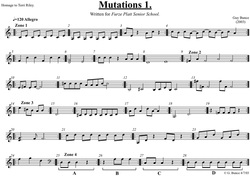Mutations I (Jan. 2003)

'Mutations I' was commissioned by Furze Platt Senior School to be performed during the opening of an A-Level seminar on genetic modification. The piece is a minimalist composition based on Riley's In C and is ideal for teaching Minimalism or for playing by amateurs.
Mutations I is designed to be played by 6-10 performers on either keyboards or tuned percussion. If the former are used, a suitable percussive tone should be employed. The structure of the piece involves each performer working through the repeated cells (1-25) in order, at their own rate - moving from one to the next when the feeling takes them. The ensemble should aim to be within 5-6 cells of each other at any one time. Cells can be played in any octave (except in Zone 4 where they should be played at pitch -or as close as possible). Also, individuals can move from one cell to the next at any point in the bar. This can be achieved with familiarity of the different cells and by listening to the resultant sound of the ensemble.
Each zone has a different harmonic centre: Zone 1, Am; Zone 2, F#m; Zone 3, Dm. Zone 4 will be discussed in due course.
One possible way of performing Mutations I involves the conductor playing a repeated high 'A' throughout in a similar manner to Riley's In C. Alternatively, the piece can be performed without the repeating 'A'.
Before performing the piece the conductor should assign each performer a letter (A-D) from Zone 4. This letter becomes the individual player's 'finishing point.' As a player reaches his/her finishing point they should repeat that finishing cell and maintain eye contact with the conductor. When the conductor is happy that every player has reached their designated finishing cell he/she should give a visual cue at which point every player holds on their note for a count of 6 beats. When assigning finishing cell, the conductor should aim to distribute the letters evenly.
Mutations I is designed to be played by 6-10 performers on either keyboards or tuned percussion. If the former are used, a suitable percussive tone should be employed. The structure of the piece involves each performer working through the repeated cells (1-25) in order, at their own rate - moving from one to the next when the feeling takes them. The ensemble should aim to be within 5-6 cells of each other at any one time. Cells can be played in any octave (except in Zone 4 where they should be played at pitch -or as close as possible). Also, individuals can move from one cell to the next at any point in the bar. This can be achieved with familiarity of the different cells and by listening to the resultant sound of the ensemble.
Each zone has a different harmonic centre: Zone 1, Am; Zone 2, F#m; Zone 3, Dm. Zone 4 will be discussed in due course.
One possible way of performing Mutations I involves the conductor playing a repeated high 'A' throughout in a similar manner to Riley's In C. Alternatively, the piece can be performed without the repeating 'A'.
Before performing the piece the conductor should assign each performer a letter (A-D) from Zone 4. This letter becomes the individual player's 'finishing point.' As a player reaches his/her finishing point they should repeat that finishing cell and maintain eye contact with the conductor. When the conductor is happy that every player has reached their designated finishing cell he/she should give a visual cue at which point every player holds on their note for a count of 6 beats. When assigning finishing cell, the conductor should aim to distribute the letters evenly.
